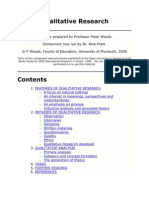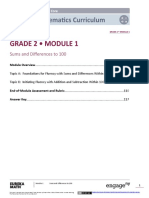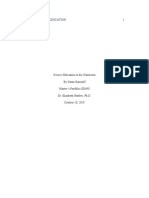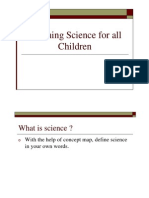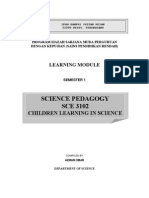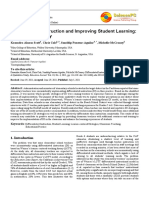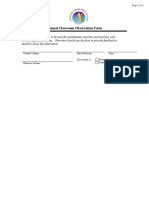Unit 1 Reflection
Unit 1 Reflection
Uploaded by
api-292313234Copyright:
Available Formats
Unit 1 Reflection
Unit 1 Reflection
Uploaded by
api-292313234Original Title
Copyright
Available Formats
Share this document
Did you find this document useful?
Is this content inappropriate?
Copyright:
Available Formats
Unit 1 Reflection
Unit 1 Reflection
Uploaded by
api-292313234Copyright:
Available Formats
Running Head: I AM A SCIENTIST
I am a Scientist:
Fostering Scientific Identity through Growth Mindset
Brianna Malone
University of Pennsylvania Graduate School of Education
I AM A SCIENTIST
Abstract
There is a negative stereotype that woman are bad at science. One of my major
concerns is that girls will enter a biology classroom having internalized this negative stereotype
into a fixed mind-set (Steele, 1997). I have designed my first week lesson plan to allow all
students to identify as scientists. By nurturing a growth mindset, I hope to inspire passion and
curiosity for science. Due to these goals my first week framework is appropriately titled, I am a
Scientist. In the first part of the week, I focus on the diversity of the scientific community and
during the later half of the week, students will explore how scientists think. I used the
methodology of Tomlinson and McTighe to create this weeks framework using backwards
design and differentiated instruction. Educational theories of Gardner, Dweck, Steele, and
Weinstein have helped shape the lesson plans differentiated design. In addition, observations
from Teaching and Learning and my fieldwork at Upward Bound Math and Science have
impacted the unit framework. I will be able to assess the successfulness of my first unit plan
during the week and throughout the semester as students confidently apply the skills of scientific
inquiry to new situations.
I AM A SCIENTIST
I am a Scientist: Fostering Scientific Identity through Growth Mindset
As a woman scientist, I defy the stereotype that woman are bad at science. One of my
major concerns is that girls will enter my classroom having internalized this negative stereotype
into a fixed mind-set. I have designed my first week lesson plan to allow all students to identify
as scientists. By nurturing a growth mindset, I hope to inspire passion and curiosity for science
(Dweck, 2010)(Steele, 1997). I would like my students forty years from now to not only identify
as scientists, but to use scientific inquiry to understand the world around them. Due to these
goals my first week framework is appropriately titled, I am a Scientist. In the first part of the
week, I focus on the diversity of the scientific community and during the later half of the week,
my students will explore how scientists think.
I used the methodology of Tomlinson and McTighe to create this week framework using
backwards design and differentiated instruction. The three stages to backwards design are to
identify desired results, determine acceptable evidence, and plan learning experiences and
instruction. Backwards design allows students to explore essential questionsto understand
important ideas contained in content standards (Tomlinson & McTighe, 2006, p. 27). To help
facilitate the learning of all students in the diverse community of Masterman, my placement
school, I have implemented differentiated instruction and assessment into my weekly plan to
serve multiple needs. I will be able to assess the successfulness of my first unit plan during the
week and throughout the semester as students confidently apply the skills of scientific inquiry to
new situations.
My first class, I begin with a constructivist method to address the question of who are
scientists and what do I have in common with scientists? I will begin with a hook: an image of a
funny cartoon of a mad scientist. I will have the students discuss what they think scientists look
I AM A SCIENTIST
like. Then, I will show students a slideshow of scientists with varying gender, age, race, and
ethnicity. I will make sure to include a picture of myself in the slideshow, as I am a woman
scientist. Then I will randomly assort students into groups of two to research a scientist. I will
give them a list of scientists that I have particularly selected to represent the diversity in the
scientific community. I have specifically chosen to put the students with a partner rather then to
individually complete the assignment because this is the first class. In Teaching and Learning,
we discussed that in the beginning of school, to create a comfortable environment, students
would prefer to work in groups. In addition, this will allow students to get to know one another.
While students research their scientist in class, I will have the opportunity to walk around and
interact with the students. As Weinstein (2011) points out in Middle and Secondary Classroom
Management, knowing your students is essential if you are to build an inclusive, caring
environment for learning (p.115). In addition, differentiated instruction suggests using varied
assessment methods. I will give students the option to present their scientist to the class using a
PowerPoint, a poster, a skit, or a song. Again, as it is the first week of school, students my not be
completely at ease with a completely free assessment style. Having specific options will provide
structure and comfort.
My first two days, I focus on exploring this diverse scientific community to allow the
students with varied culture to identify commonalities between themselves and scientists. Girls
in particular often feel a disconnect in science classes. This is due to what Claude Steele refers to
as stereotype threat. A negative stereotype exists that women are bad at science or cant do
science. The stereotype is often internalized in girls becoming part of their identity. The
outcomes of this fixed mindset can be deleterious to their performance in science class (Steele,
1997). Carol Dweck has suggested that a growth mindset can combat a fixed mindset. A growth
I AM A SCIENTIST
mindset implies that with effort we can grow our intellectual ability (Dweck, 2010). My hope in
targeting this fixed mindset, that girls are bad at science, early on is so that girls will be able to
identify as scientists and see success in science class as tangible.
The second half of the week, I will address how scientists think. I will explore the
essential questions: how do scientists use methods of inquiry to understand the world and how
can you use the scientific inquiry to understand the world around you? I will begin this section
on scientific method by having students complete the following do now: describe a problem you
have encountered in your environment and how you solved or tried to solve it. This will lead into
a behaviorist lesson on the scientific inquiry. Students will need to know the steps to the
scientific method and the relevant experimental terminology such as hypothesis, positive and
negative control, independent variable, and dependent variable. This base knowledge will allow
them to build the skills necessary for inquiry as a scientist and to properly communicate within
the global scientific community. In my fieldwork with high school students in a summer STEM
program, I noticed students struggled with how to develop a hypothesis in labs. They found it
difficult to understand that a hypothesis does not need to be correct. In my lesson, I will
emphasis this by giving an example with a hypothesis that my data refutes. Lastly, to tie my
lesson on the scientific inquiry to steps of the scientific method that they may have already used
in inquiry, I will conclude the class by having the students identify in their do now steps of the
scientific method. By connecting new knowledge to old knowledge the students already possess,
they will have a greater understanding of inquiry and be able to connect scientific thinking as
their own.
The last two days of the week will allow students to explore the scientific method
through a gummy bear experiment. Students will develop the skills of inquiry: to form and test a
I AM A SCIENTIST
hypothesis and to analyze quantitative results using statistical analysis. This two-day experiment
touches on Gardners theory of Multiple Intelligence. His theory includes eight distinct types of
intelligences: spatial, bodily kinesthetic, musical, linguistic, logical-mathematical, interpersonal,
intrapersonal, and naturalistic (Multiple Intelligences, 2015). While working with high school
students in lab, I have observed that the lab environment allows students diverse intelligences to
thrive. Someone with a strong bodily-kinesthetic intelligence will thrive in the hands-on active
lab environment. Someone with interpersonal intelligence will work well and efficiently with his
or her lab partner. Someone with visual/special will benefit from observational changes in
reactants. Someone with a naturalistic intelligence will enjoy exploring his or her environment
through scientific inquiry. Lastly someone with a logical-mathematical intelligence will excel at
data analysis.
In the gummy bear lab, students will use the scientific method to explore the affect of a
chosen liquid on the size of a gummy bear. I chose gummy bears because it is a fun, low stress
lab for their first exposure to the scientific method. I have added a component of competition to
the lab. In my summer fieldwork, I noticed that students enjoyed the competition of survival of
the fittest while completing a lab on evolution. In addition, the head of the science department at
Masterman, informed us at the Meet Your Mentor Night, that the students at Masterman are very
competitive and enjoy competing. I added a class competition to the gummy bear experiment.
The students will compete for the greatest increase and decrease in gummy bear size. Lastly,
while designing the lab, I created a clear and concise procedure because I found in my fieldwork
that students were lost and confused when the instructions were unclear.
After students have completed the lab, I designed a writing prompt to assess whether
students understand limitations of the scientific method and if they can translate scientific
I AM A SCIENTIST
inquiry to other subjects. I found in my fieldwork when we presented photosynthesis to the high
school students, they were more comfortable contributing to questions that did not have a correct
answer. This prompt provides students with the opportunity to critical apply and critique the
limitations of the scientific method.
The culmination of this unit will be an I am a Scientist bulletin board that I will keep in
the classroom the entire year. As was mentioned in Teaching and Learning, students no matter
the age enjoy working with markers. I will have the students complete with marker and an index
card the phrase: I am a scientist because_________. I will then take a picture of each student
as a scientist. I will place the students picture and their sentence on the bulletin board. Lastly, as
closure, I will assess students comfort and enjoyment of scientific inquiry by conducting a brief
survey. This will help me reflect on the successfulness of the unit plan and where students may
be struggling.
As I have never conducted this lesson plan, I have some questions about its
implementation. My first concern is that the class periods at Masterman may not give me enough
time to fulfill all the content prepared in one week. Secondly, since the students are in high
school should I be more direct with them discussing the negative stereotype that women are bad
at science exists? Will students with special needs struggle with the experimental portion or
English language learners have difficulty with the scientific inquiry vocabulary? In addition,
have students had prior knowledge of the scientific method and will find the experiment too
easy? Lastly, if I have a student who is vegan will they be comfortable working with gummy
bears?
I AM A SCIENTIST
References
Dweck, C.S. (2010). Mind-Sets and Equitable Education. Principal Leadership, 10(5): 26-29
Multiple Intelligences Oasis (2015). Multiple Intelligences Oasis - Howard Gardner's Official
MI Site. Retrieved 12 August 2015, from http://multipleintelligencesoasis.org/
Steele, C.M. (1997) A Threat in the Air: How stereotypes shape intellectual identity and
performance. American Psychologist 52 (6), 613-629
Tomlinson, C. A., & McTighe, J. (2006). Integrating differentiated instruction & understanding
by design: Connecting content and kids. Alexandria, Va: Association for Supervision and
Curriculum Development.
Weinstein, C. S. (2011). Middle and secondary classroom management: Lessons from research
and practice (4th ed.). New York: McGraw-Hill.
You might also like
- Special Education Teacher Interview Questions!Document6 pagesSpecial Education Teacher Interview Questions!alkearns011493% (15)
- Lesson Plan - Mental Health - 4Document7 pagesLesson Plan - Mental Health - 4api-518393422No ratings yet
- Qualitative ResearchDocument55 pagesQualitative ResearchGultaj Bangash100% (3)
- Grade 2 - Module 1: Mathematics CurriculumDocument17 pagesGrade 2 - Module 1: Mathematics CurriculumBernard Jayve PalmeraNo ratings yet
- Interview Carl WiemanDocument6 pagesInterview Carl WiemanRino BurkhardtNo ratings yet
- Strategies in Teaching Science in Elementary Grades: Utilize Developing Math Skills and Problem-SolvingDocument11 pagesStrategies in Teaching Science in Elementary Grades: Utilize Developing Math Skills and Problem-SolvingFerdinand ReymundoNo ratings yet
- 6436 FinalDocument23 pages6436 FinalSadia RiazNo ratings yet
- Gelli Module EducDocument8 pagesGelli Module EducGellirose S. BantayanNo ratings yet
- Unit 1 Introduction To ScienceDocument34 pagesUnit 1 Introduction To ScienceCharlene PortugalNo ratings yet
- Educ 535 lt3 Caldwell BDocument5 pagesEduc 535 lt3 Caldwell Bapi-390725209No ratings yet
- Centrella Teaching Philosophy 2015 For PortfolioDocument4 pagesCentrella Teaching Philosophy 2015 For Portfolioapi-302769620No ratings yet
- Tips For Teaching Science To Elementary StudentsDocument2 pagesTips For Teaching Science To Elementary StudentsAbner CruzNo ratings yet
- Parent News Letter ScienceDocument4 pagesParent News Letter Scienceapi-606355723No ratings yet
- Motivating Young Students To Be Successful in ScienceDocument26 pagesMotivating Young Students To Be Successful in ScienceShaniaNo ratings yet
- Mock RocksDocument3 pagesMock Rocksapi-314551798No ratings yet
- SCI-M-3114 - P 4-7 Chapter 1Document4 pagesSCI-M-3114 - P 4-7 Chapter 1CHENIE MISANo ratings yet
- ArtifactDocument6 pagesArtifactapi-516988940No ratings yet
- Researchers On Science Education. John. R. StaverDocument6 pagesResearchers On Science Education. John. R. StaverRavin RagbeerNo ratings yet
- Magic School BusDocument3 pagesMagic School Busapi-231750421No ratings yet
- Science EducationDocument7 pagesScience EducationRyan Ceazar AguilaNo ratings yet
- Implementing Philosophy in Elementary Schools: The Washington Elementary School Philosophy ProjectFrom EverandImplementing Philosophy in Elementary Schools: The Washington Elementary School Philosophy ProjectRating: 5 out of 5 stars5/5 (1)
- Sci-201-Teaching Science in Elementary GradesDocument28 pagesSci-201-Teaching Science in Elementary GradesbarredajohnpatrickNo ratings yet
- Usando Anomallias para Facilitar Ensino em Saula de AulaDocument14 pagesUsando Anomallias para Facilitar Ensino em Saula de Aulajohnny bgoodNo ratings yet
- Educ Journal Article CritiqueDocument7 pagesEduc Journal Article Critiqueapi-378042907No ratings yet
- Science Education Frame FinalDocument4 pagesScience Education Frame Finalapi-508948800No ratings yet
- Goal 4 5 - Science Framing StatementDocument6 pagesGoal 4 5 - Science Framing Statementapi-665661592No ratings yet
- Past Science CourseworkDocument5 pagesPast Science Courseworkjxaeizhfg100% (2)
- InquiryPart1 PDFDocument62 pagesInquiryPart1 PDFTiagoBernardiniNo ratings yet
- 0696 1st AssignmentDocument35 pages0696 1st AssignmentAsad DogarNo ratings yet
- Teaching Science For All ChildrenDocument27 pagesTeaching Science For All ChildrenFad AsshafieeNo ratings yet
- Modul SC 3102Document43 pagesModul SC 3102Atsani KatminNo ratings yet
- Scientific Inquiry Lesson For Second GradeDocument6 pagesScientific Inquiry Lesson For Second GradeGabrielle DeSano0% (1)
- Creativity in Science: Leaping The Void: Juliet EdmondsDocument10 pagesCreativity in Science: Leaping The Void: Juliet EdmondsedNo ratings yet
- 2 Kristina MeadDocument15 pages2 Kristina MeadceppdiNo ratings yet
- Lab Arts ExamDocument4 pagesLab Arts ExamPhil LajomNo ratings yet
- Sa Final311Document19 pagesSa Final311api-532939717No ratings yet
- REFLECTIONSDocument3 pagesREFLECTIONSAldemar Masambay Ytac CuatonNo ratings yet
- Week 2: Teaching Science in The Intermediate GradeDocument15 pagesWeek 2: Teaching Science in The Intermediate GradeHerlyn BautistaNo ratings yet
- MIDTERMSDocument9 pagesMIDTERMSMichael T. SebullenNo ratings yet
- Mind - Research Upends Traditional Thinking On Study Habits - NYTimesDocument5 pagesMind - Research Upends Traditional Thinking On Study Habits - NYTimesnkorfNo ratings yet
- Statement of Teaching PhilosophyDocument2 pagesStatement of Teaching PhilosophyVirendra MauryaNo ratings yet
- Teaching Science in Elementary Grades Reviewer-1Document31 pagesTeaching Science in Elementary Grades Reviewer-1Shaira100% (1)
- Edu 201 Philosophy Paper AddendumDocument9 pagesEdu 201 Philosophy Paper Addendumapi-531486255No ratings yet
- Research Matters - To The Science Teacher No. 8902 April 1, 1989Document5 pagesResearch Matters - To The Science Teacher No. 8902 April 1, 1989Kurtis HarperNo ratings yet
- Learning in EducationxxxxDocument15 pagesLearning in EducationxxxxHaerudinNo ratings yet
- Ed 698 Science ContentDocument5 pagesEd 698 Science Contentapi-383410279No ratings yet
- Module 1Document4 pagesModule 1Allen Mae ColoniaNo ratings yet
- 8627-2 (English)Document13 pages8627-2 (English)supdt cityNo ratings yet
- Module 1 TEAPHYDocument4 pagesModule 1 TEAPHYvmmatmatNo ratings yet
- K-L Lesson Plan FinalDocument17 pagesK-L Lesson Plan Finalapi-315554878No ratings yet
- Rutchell P. Maleriado Dr. Ma. Anavi EchavarriDocument3 pagesRutchell P. Maleriado Dr. Ma. Anavi EchavarriRosalie SaavedraNo ratings yet
- Jaber and Hammer 2016 Learning To Feel Like A ScientistDocument32 pagesJaber and Hammer 2016 Learning To Feel Like A ScientistrodrigohernandezNo ratings yet
- Annotated Bibliographies For WeeblyDocument13 pagesAnnotated Bibliographies For Weeblyapi-475656691No ratings yet
- Critical Thinking and Technology: Intrinsic MotivationsDocument6 pagesCritical Thinking and Technology: Intrinsic Motivationsluke74sNo ratings yet
- Science PresentationDocument10 pagesScience PresentationRheamar Angel MolinaNo ratings yet
- 6ºreproduction and Its Stages 2013Document4 pages6ºreproduction and Its Stages 2013DocumentosCarsonNo ratings yet
- Annotated Activity SequenceDocument6 pagesAnnotated Activity Sequenceapi-249804589No ratings yet
- IRYN - Oct 18Document28 pagesIRYN - Oct 18yellstt2672No ratings yet
- Science StatementDocument3 pagesScience Statementapi-438615530No ratings yet
- Benjamin - Equity in Science LearningDocument4 pagesBenjamin - Equity in Science Learningapi-578105135No ratings yet
- Uncovering Student Ideas in Science, Volume 4: 25 New Formative Assessment ProbesFrom EverandUncovering Student Ideas in Science, Volume 4: 25 New Formative Assessment ProbesNo ratings yet
- Letter of Recommendation For Sarah LivingstonDocument1 pageLetter of Recommendation For Sarah Livingstonkguy_12No ratings yet
- Differentiated Instruction and ImprovingDocument5 pagesDifferentiated Instruction and ImprovingyeuvanNo ratings yet
- Formal Classroom Observation FormDocument6 pagesFormal Classroom Observation FormwaleedalihamzahNo ratings yet
- GRADES 1 To 12 Daily Lesson Log Monday Tuesday Wednesday Thursday FridayDocument5 pagesGRADES 1 To 12 Daily Lesson Log Monday Tuesday Wednesday Thursday FridayaizaNo ratings yet
- Ellanas Lesson LogDocument4 pagesEllanas Lesson LogElmera Jean Gajilomo EllanaNo ratings yet
- DLL 10Document7 pagesDLL 10Aljo Palma CatedralNo ratings yet
- Nutrition Unit Plan UbdDocument14 pagesNutrition Unit Plan Ubdapi-346205571No ratings yet
- Unit PlanDocument2 pagesUnit Planapi-509660639No ratings yet
- MTB 1 - Q3 - W2 DLLDocument8 pagesMTB 1 - Q3 - W2 DLLMichelle Angela TafallaNo ratings yet
- POMPONG LP - Final DemoDocument7 pagesPOMPONG LP - Final DemoErap UsmanNo ratings yet
- Ell Differentiation GuideDocument3 pagesEll Differentiation Guideapi-277941915No ratings yet
- Teaching ProfessionDocument8 pagesTeaching ProfessionDanilo Siquig Jr.No ratings yet
- Marjorie Mcdonald Resume 2018Document2 pagesMarjorie Mcdonald Resume 2018api-410013450No ratings yet
- 6088 Liberty Kleinfeldt Unit 5 Blended Learning 99970 1545750822Document5 pages6088 Liberty Kleinfeldt Unit 5 Blended Learning 99970 1545750822api-709488952100% (1)
- DLL - Science 4 - Q2 - W6Document3 pagesDLL - Science 4 - Q2 - W6KRISTINE JOAN BARREDONo ratings yet
- Fs 1 Module 1 9 OutlineDocument13 pagesFs 1 Module 1 9 OutlineDONNA FEI MORENONo ratings yet
- SDLC Instructional Performance Rating Rubric Fy13Document9 pagesSDLC Instructional Performance Rating Rubric Fy13api-184947815No ratings yet
- Teaching Work Sample - FinalDocument59 pagesTeaching Work Sample - Finalapi-427017406No ratings yet
- Lesson Plan Art: Chalk Bat ShadowsDocument4 pagesLesson Plan Art: Chalk Bat Shadowsapi-301371005No ratings yet
- Resume 2015-15Document4 pagesResume 2015-15api-300874571No ratings yet
- Lesson Plan and Reflection Assignment: EDRL 473/673Document24 pagesLesson Plan and Reflection Assignment: EDRL 473/673api-386425748No ratings yet
- Math 9 Week 1 Day 2Document7 pagesMath 9 Week 1 Day 2Meleza Joy SaturNo ratings yet
- Monthly Supervisory Plan 2020-2021 TleDocument5 pagesMonthly Supervisory Plan 2020-2021 TleSheryl Aquino BacaniNo ratings yet
- DLL - Mathematics 1 - Q3 - W3Document5 pagesDLL - Mathematics 1 - Q3 - W3Patricia Orbe CañeteNo ratings yet
- Test Question Prof Ed TLE 105 Foundations of Special and Inclusive EducationDocument4 pagesTest Question Prof Ed TLE 105 Foundations of Special and Inclusive EducationMikyle NatorNo ratings yet
- Elec 2 - Unit 3Document15 pagesElec 2 - Unit 3Lala CababaoNo ratings yet
- A Usaid-Elsa-Pbsp Project: EQUALLS2: Education Quality and Access For Learning and Livelihood Skills 2Document4 pagesA Usaid-Elsa-Pbsp Project: EQUALLS2: Education Quality and Access For Learning and Livelihood Skills 2gs1 adzuNo ratings yet


